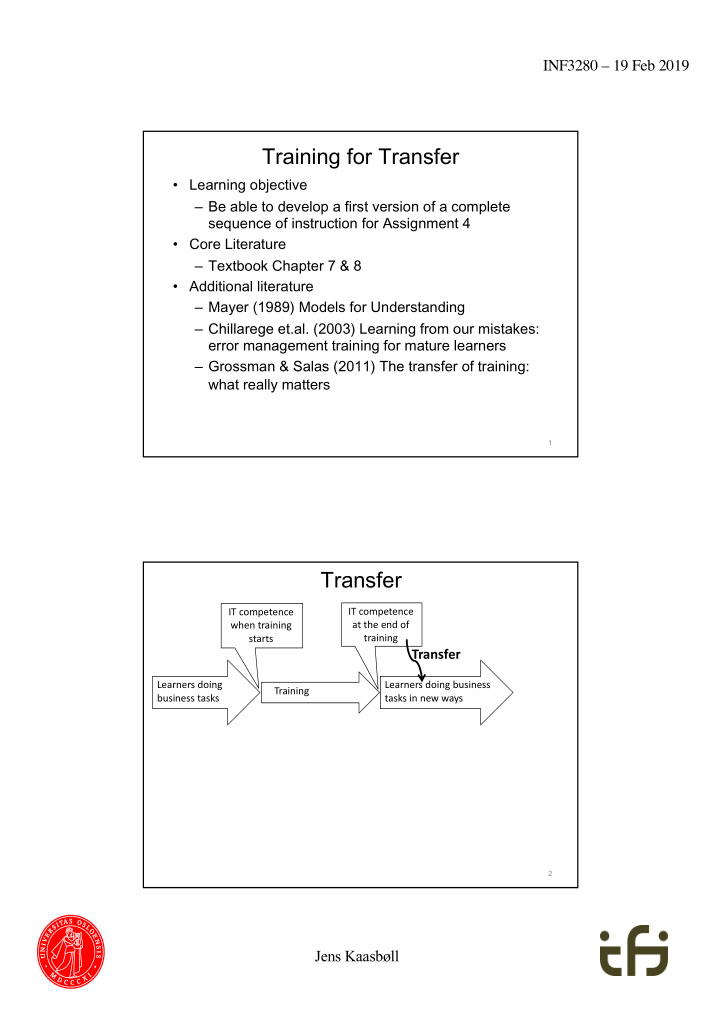



INF3280 – 19 Feb 2019 Training for Transfer • Learning objective – Be able to develop a first version of a complete sequence of instruction for Assignment 4 • Core Literature – Textbook Chapter 7 & 8 • Additional literature – Mayer (1989) Models for Understanding – Chillarege et.al. (2003) Learning from our mistakes: error management training for mature learners – Grossman & Salas (2011) The transfer of training: what really matters 1 Transfer IT competence IT competence when training at the end of starts training Transfer Learners doing Learners doing business Training business tasks tasks in new ways 2 Jens Kaasbøll
INF3280 – 19 Feb 2019 What went wrong – 1 The training for the new corporate information system Training concerning accounting, stock and production, took place as planned. During 50 training sessions, each lasting for 2 hours, a total of 1500 staff members were given hands on training on all of the functions in the system. When starting up, the three system support technicians Use were completely bogged down with all kinds of questions from users. Most of these questions had been covered in the training. 3 What went wrong – 2 Training Each group of 20 staff were given training for the new workflow system for a whole day. Two weeks were spent on training to cover all 200 users. The system implementation was unfortunately delayed for a couple of months due to some software issues. When starting up, very few people actually used the Use system. Upon request, they said they didn’t know how. 4 Jens Kaasbøll
INF3280 – 19 Feb 2019 What went wrong – 3 Training for the new client and customer system was Training carried out for one hour. In addition, the participants were requested to become member of the corporate FaceBook group where they could ask questions and find instruction videos. A big mess appeared at system implementation Use Customers were double and triple registered, often with somewhat different contact information. The customer statistics was completely flawed. 5 Factors improving transfer IT competence IT competence when training at the end of starts training Transfer Learners doing Learners doing business Training business tasks tasks in new ways + Opportunities to perform + Motivation including timing + Imitation + Social influence + Realistic training environment + Support + Problem solving + Self-efficacy Today Previously 6 Jens Kaasbøll
INF3280 – 19 Feb 2019 Timing • When the system can be used immediately after the course • Because – Forgetting half of what’s learnt in one month – Waiting is demotivating 7 Result of Training and Transfer Learning outco comes s after Outco comes s of Transf sfer Training Tr • What the trainee is capable • The change in the business of doing after training as a result of training Example • Being able to use • Monthly customer contact CustManager for • 10% sales increase – Updating – Correcting customer data – Reporting – Responding to alerts 8 Jens Kaasbøll
INF3280 – 19 Feb 2019 Learners’ background Participants at the same level of competence Too advanced à learners do not understand Too simple à learners get bored or disturb others 9 Training module for skills and understanding Training activities and scaffolds Learning outcomes 1. Introductory presentation of – Learning objective • Usefulness for Individual or Business – Business / Functional / Structural models Vague understanding 2. Practicals – Handing out Minimal Manuals, exercises – Guiding learners Skills 3. Summary – Discuss Usefulness with learners – Discuss Structure and functionality with learners • Possibly a test – Confront misconceptions Understanding 10 Jens Kaasbøll
INF3280 – 19 Feb 2019 Prerequisites before new concepts Module on understanding r Table of Contents e d Module on understanding r o Styles y n Module for problem solving A with Styles 11 Concepts which are specialisations of other concepts Proceed Table of Index to more Contents e . abstract s r t o p m concept e r c e o n d Cross Reference t o r d c o e reference c y e i f n c based on i o A Footnote c r e two P p s specific Bookmark concepts 12 Jens Kaasbøll
INF3280 – 19 Feb 2019 Pair working learners • Improves understanding • Prepares for continued conversation after training 13 Training environment differs from use environment • Negative for transfer Course − transfer Business − transfer 14 Jens Kaasbøll
INF3280 – 19 Feb 2019 Realistic training environment + transfer Course Business Course leader Business manager Reach agreement on participants and course content Classroom Workplace Reduce use of projector – furnish participants with handouts Classmates and teacher Colleagues and superiors Several colleagues to the same training Simple and unknown examples Real and known examples Use business examples in training 15 Factors improving transfer IT competence IT competence when training at the end of starts training Transfer Learners doing Learners doing business Training business tasks tasks in new ways + Opportunities to perform + Motivation including timing + Imitation + Social influence + Realistic training environment + Support + Problem solving + Self-efficacy 16 Jens Kaasbøll
INF3280 – 19 Feb 2019 Golden rules for IT user training 5. 5. Divi vide training into 30 minutes s modules s and incl clude problem so solvi ving modules s 6. 6. Organise se training at the sa same time as s the syst system is s inst stalled. 17 Jens Kaasbøll
Recommend
More recommend